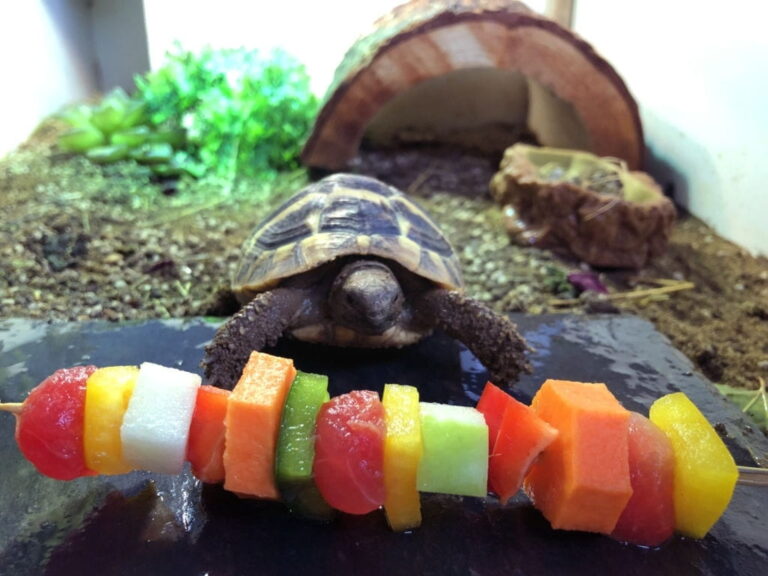Here is the question that many tortoise lovers will doubt: Can Russian tortoises eat carrots? The answer is: Yes, Russian tortoises can eat carrots and tops. Do not feed excess carrot tops to the Russian tortoises due to the fact that this is the source of oxalic acid. This oxalic acid can interfere with calcium metabolism and cause kidney or bladder stones if your tortoises are fed excessively carrots.
Table of Contents
Can Russia Tortoise Eat Carrots?
Raw carrot roots and tops are safe for tortoises to consume. Carrot tops, on the other hand, should be used sparingly by tortoises due to their high protein and potassium content. Carrot tops also contain oxalic acid, which can interfere with calcium absorption and produce kidney and bladder stones if consumed in large quantities.
Vegetables, greens, and other plant materials such as flowers and weeds should only be part of a tortoise diet.
Feeds heavy in fiber, such as hays like alfalfa hay, should account for the majority of the tortoise’s diet. As part of a balanced daily diet, you may also provide high-quality tortoise pellets, such as these selections from Amazon.
Nutrition Value Of Carrot
According to USDA (US Department of Agriculture), here is the nutritional breakdown of 1 raw baby carrot (10g), which would be a suitable serving size for a tortoise:
|
Name | Amount |
|
Calories |
4 |
|
Water |
8.8 g |
|
Carbohydrates |
0.95 g |
|
Protein |
0.09 g |
|
Fiber |
0.28 g |
|
Calcium |
3.3 mg |
|
Phosphorus |
3.5 mg |
|
Potassium |
32 mg |
|
Vitamin C |
0.59 mg |
|
Iron |
0.03 mg |
|
Vitamin D |
0 |
|
Vitamin A |
83.5 IU |
| Vitamin K |
1.32 µg |
Advantages Of Feeding Carrots To Russian Tortoises
Feeding carrots especially baby carrots brings a lot of benefits to Russian tortoises. It is listed as followed:
1. Water
It is critical to keep your tortoise hydrated in order to maintain and keep its body systems healthy. On a regular basis, make sure your pet tort has access to a dish of clean and fresh water. Similarly, you can keep your pet hydrated by giving them vegetables; most vegetables have a high water level, and carrots have around 87 percent water content.
Carrots, along with other vegetables, should be fed to tortoises as part of their diet to help them stay hydrated. However, vegetables should not be used as the major source of water, and they should always be given a bowl of water.
2. Fiber, protein and Fats
Fiber, protein, and fats are all important components of a healthy diet. Because tortoises are herbivores, they need a lot of fiber in their diet to create energy. Tortoises’ primary source of energy is a carbohydrate generated from fiber breakdown. Tortoises, in general, use fermentative digestion.
This kind of digestion results in the production of short-chain fatty acids, which are utilized for energy. Fiber should make up about 10% to 40% of a tortoise’s dry matter, with 18% to 28% being the optimal fiber content of the dry matter.
Fats and proteins can also be used as an alternate source of energy; fats should account for less than 10% of total calories, while proteins should account for 15% to 35% of total calories.
Too much fat can limit calcium absorption and lead to obesity in tortoises, especially those that do not receive enough activity.
3. Minerals
Minerals have a critical role in the growth and development of tortoises, as well as all reptiles. Given that a tortoise’s shell is made up of minerals like calcium and phosphorus. To avoid deformed shell and skeleton construction, make sure your turtle gets enough of these nutrients in its diet.
Calcium is the most abundant element in a tortoise’s body, accounting for almost three-quarters of the elements in a tortoise’s makeup when paired with phosphorus.
In reality, the absorption of these two minerals in the bodies of all animals is influenced by them. When phosphorus levels in the diet are higher than calcium levels, calcium absorption might be hampered. Calcium phosphates are formed when phosphorus reacts with calcium, limiting calcium absorption. As a result, the suggested calcium to phosphorus ratio for tortoises’ main food should be either 1:1 or 2:1.
Carrots have a calcium-to-phosphorus ratio of around 1:1, making them a suitable food for torts when eaten moderately alongside other veggies.
Other variables that impact calcium absorption besides phosphorus include oxalic acid, phytic acid, and a high fat diet. As a result, you should only eat spinach in moderation and never eat avocado. Calcium absorption is also affected by the amount of calcium in the diet and the body’s calcium demand.
How To Feed Russia Tortoises Carrot
Now move the most important part, how to feed your tort in an easy and effective way. You should follow these steps:
- Wash carrots thoroughly
- Tortoise can eat both carrot stems and carrots tops
- Cut them into pieces and mix them up with other veggies for a balanced diet
- Never feed veggies on a sand background, use a tortoise slab
- Remove any uneaten veggies at the end of the day
Note: Food Can Not Be Provided To Russian Tortoises.
In addition, they may include tiny fruit such as apples and berries. Iceberg lettuce, cereals, or nutrient-deficient meat should not be fed to tortoises. Commercially available pellet diets can be offered to Russian Tortoises, however many of them include excessive quantities of starch and are nutritionally unbalanced.
Conclusion
Carrots are safe for all tortoises, however they should only be served in little amounts. The best strategy is to make sure you get a variety of vegetables rather than just one.

